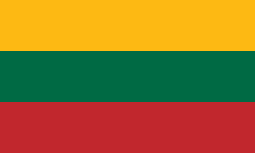Flag of Lithuania
 |
|
| Use | National flag and civil ensign |
|---|---|
| Proportion | 3:5 |
| Adopted | 1918 (modifications made in July 2004) |
| Design | A horizontal triband of yellow, green and red. |

Variant flag of Lithuania
|
|
| Use | State flag |
| Proportion | 3:5 |
| Adopted | 2004, first documented use 1410. |
The flag of Lithuania consists of a horizontal tricolor of yellow, green and red. It was re-adopted on March 20, 1989, almost two years before the re-establishment of Lithuania's independence and more than three years before the collapse of the Soviet Union.
It was first used in Lithuania's first period of independence (in the 20th century) from 1918 to 1940, which ceased with the occupation first by Soviet Russia and Lithuania's illegal annexation into the Soviet Union, and then by Nazi Germany (1941–44). During the post-World War II Soviet occupation, from 1945 until 1989, the Soviet Lithuanian flag consisted first of a generic red Soviet flag with the name of the republic, then changed to the red flag with white and green bars at the bottom. The last alteration to the current flag occurred in 2004 when the aspect ratio changed from 1:2 to 3:5.
The earliest known flags with a Lithuanian identity were recorded in the 15th-century Banderia Prutenorum, written by Jan Długosz. At the Battle of Grunwald in 1410, two distinct flags were present. The majority of the 40 regiments carried a red banner depicting a mounted knight in pursuit. This flag, known as the Vytis, would eventually be used as the Lithuanian war flag, and again in 2004 as the state flag. The remainder of the regiments carried a red banner displaying the Columns of Gediminas. Those that bore the Vytis, also known as the Pahonia, were armies from the Grand Duchy of Lithuania, while those who bore the Columns of Gediminas were from noble families of Lithuania. Until the end of the 18th century, when it was annexed by the Russian Empire, the Grand Duchy of Lithuania used the Vytis as its flag.
...
Wikipedia
